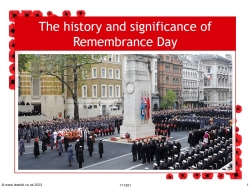What is Remembrance Day? Assembly
A clear and visually striking PowerPoint and assembly plan to explain the history of Remembrance Day.
The assembly explores the WW1 armistice, the Remembrance Sunday Service, the two-minute silence, the tradition of wearing poppies and the poem 'In Flanders Fields', and the significance of the Cenotaph.
Assembly objectives:
- To understand what Remembrance Day is and why we mark the occasion.
- To understand the history and significance of the event, including the symbolism of the poppy.
- To enable students to acquire a broad general knowledge of and respect for public institutions and services in England. (SMSC, British Values)
This resource is perfect as a whole school assembly, or you could use the PowerPoint as a KS1/KS2 lesson starter.
You may also like our other Remembrance Day resources.
An extract from the assembly plan:
Slide 8 – What do we do on Remembrance Day?
At 11 o’clock in the morning, we have a two-minute silence, which is a time for reflection. This time is chosen because it was exactly 11am on the 11 November 1918 that the fighting ended.
Ask: How do you think the surviving soldiers felt when they heard that the war was over?
Discuss the feelings of elation and relief they must have been feeling, along with sorrow for the friends and comrades they had lost during the war who would be unable to make it home with them.
Ask: What will you think about during the two-minute silence?
Slide 17 – What do we mean by ‘Lest we forget’?
The phrase ‘Lest we forget’ is often linked to Remembrance Day. It encourages us to remember the bravery of the fallen soldiers and reminds us to strive for peace and understanding in the future.
Ask: What are some ways that we can promote peace and understanding in our school community?

